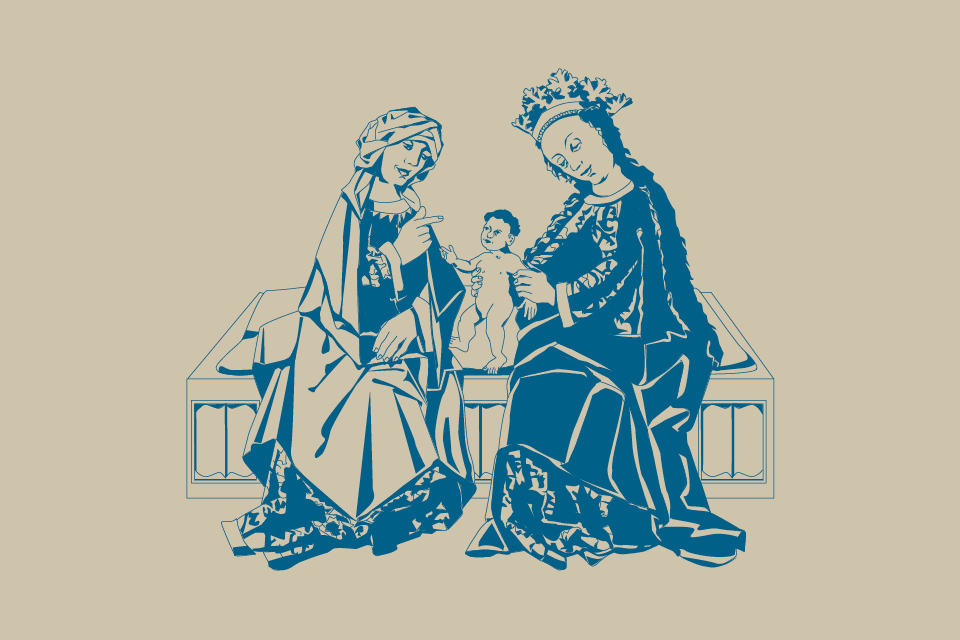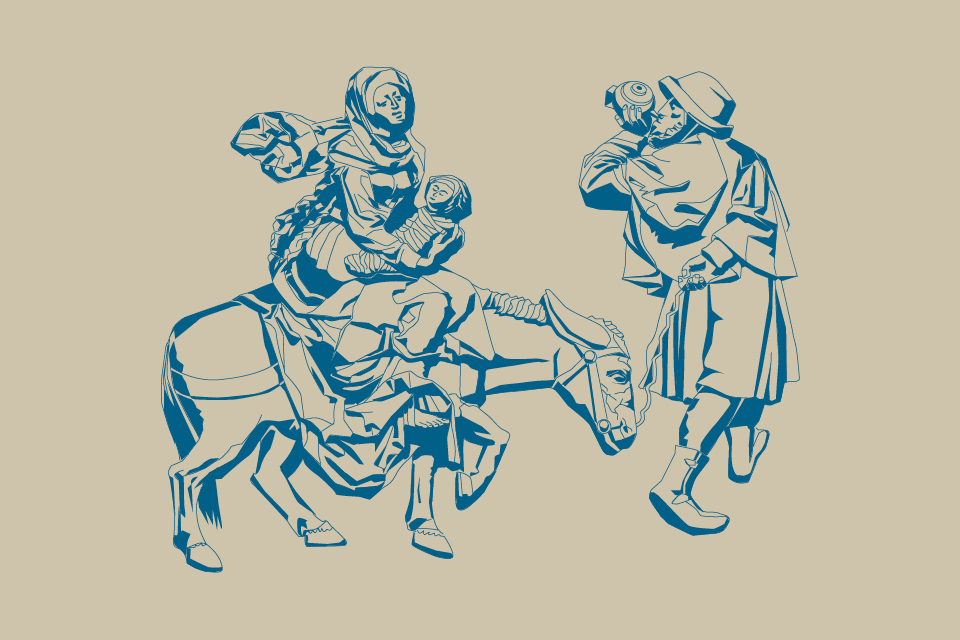NOTHING FOUND!
Maria, Mutter Jesu
Lady of Mercy
Mary is the most acclaimed woman in the Bible; she is the Mother of Jesus Christ. She is also referred to as Mother of God, Queen of Heaven and Our Lady (Italian: Madonna). She wears a blue coat and headscarf with a golden rim and a red or green dress. She was initially shown as Queen sitting on a throne, later on standing upright as mother and woman. She is the gracious ruler and protector of the faithful. This is shown in the image of the Lady of Mercy following the medieval tradition of the “protective coat”: women of nobility had the right to provide asylum to those who asked for it by sheltering them under their coat. Thus, Mary evolved as intercessor with God. She opens her coat and grants people her protection under it.
Madonna on a crescent moon
Mary is often called “Our Dear Lady”, this is “Liebfrauen” in German. In both languages this connotes the idea of a female master (mistress) rather than just the female gender. The German church name “Liebfrauen” or “Unser Lieben Frauen” is slightly misleading. “Frauen” seems to indicate a plural form (several ladies), it is, however, an early genitive: Church of Our Dear Lady. In catholic prayers Mary is frequently addressed to as “Our Dear Lady.” Many monastic and other communities in which religious people gather to be close to one another bear this name. Sometimes Mary is shown standing or sitting on a moon. This depiction is called “Madonna on a crescent moon”. Mary is the woman who is surrounded by eternal sunlight. She is holding her divine son. The moon at her feet represents both transitoriness and constant change.
Annunciation
In the New Testament of the Bible, Matthew and Luke say that the Holy Spirit is with Mary. As a virgin she would give birth to a child, the “Son of the Highest”. The message is conveyed by an angel, the angel Gabriel. This is why the scene is known as the Angelic Salutation. Gabriel says to Mary: “Do not be afraid – with God nothing is impossible.” The Holy Spirit is often visualised as a dove, the symbol of peace, which was also used by Pablo Picasso (1881–1973). Frequently the angel holds a white lily as a sign of blessing given to Mary. After receiving the news that she is pregnant she sings one of the most beautiful songs in the Bible. It is called “Magnificat” after its first Latin word and it has been sung to the present day in all Christian churches: “My soul magnifies the Lord and my spirit rejoices in God, my Saviour … For he who is mighty has done great things for me, and holy is his name.“
Anna Selbdritt
Das Leben Marias wird nicht in der Bibel, aber im berühmtesten Volksbuch des Mittelalters, der »Legenda Aurea«, beschrieben. Die Einbindung der Großmutter Anna ist wichtig für das Verständnis von Kirche und Familie. Anna trägt ein Kopftuch, Maria eine Krone. Das Bild heißt »Anna selbdritt« – Anna zu dritt. Es gibt auch Bilder der Großfamilie mit den Großeltern Anna und Joachim, Maria mit ihrem Mann Josef und Jesus als Kind.
– nach der Seitenflügel-Altartafel »Heilige Familie«, um 1480, St.-Nikolai-Kirche Stralsund
Mary holding little Jesus, Flight into Egypt
The picture of Mary holding little Jesus is the most touching image in the Bible: a happy mother with her baby. This image has already been around since the second century. At this time, Mary was shown majestically as Queen of Heaven on her throne looking very serious and solemn, holding Jesus in her lap, both facing the viewer. From 1200 onwards, Mary has been portrayed with increasingly motherly and feminine features. She is turning towards her child. Her devotion becomes visible in an intimate mother-child-relationship. She carries Jesus in her arms, holding him safely and presenting him happily. Jesus can often be seen holding a symbol of his later life – the globe or an apple signifying the new creature. Frequently, the small family of Mary, Jesus and Joseph is depicted – a patchwork family 2000 years ago – at Christmas in Bethlehem or on their way to Egypt fleeing Herod.
Mother of Sorrows
The Mother of Sorrows (Latin “Mater dolorosa“) showing the grieving mother and the Pietà displaying Mary together with her son who had died at the cross both serve to show compassion for Mary at the death of her son. Her grief embodies the suffering of all mothers who have lost a child. Numerous artists have taken up this subject in their design of war memorials, for example Käthe Kollwitz (1867–1945) and Ernst Barlach (1870–1938). Mary’s life is described in one of the most widely read books of the middle ages, the “Legenda Aurea”. A vision of Mary can be found in the Revelation to John. Here, Mary is sitting or standing on a moon. This depiction is called “Madonna on a crescent moon”. Mary is the woman who is surrounded by the eternal sunlight. She is holding her divine son. The moon at her feet represents both transitoriness and constant change.
Maria, Mutter Jesu
– nach Raffael da Urbino (1483–1520): »Sixtinische Madonna«, 1512/13, Gemäldegalerie Alte Meister, Staatliche Kunstsammlungen Dresden









